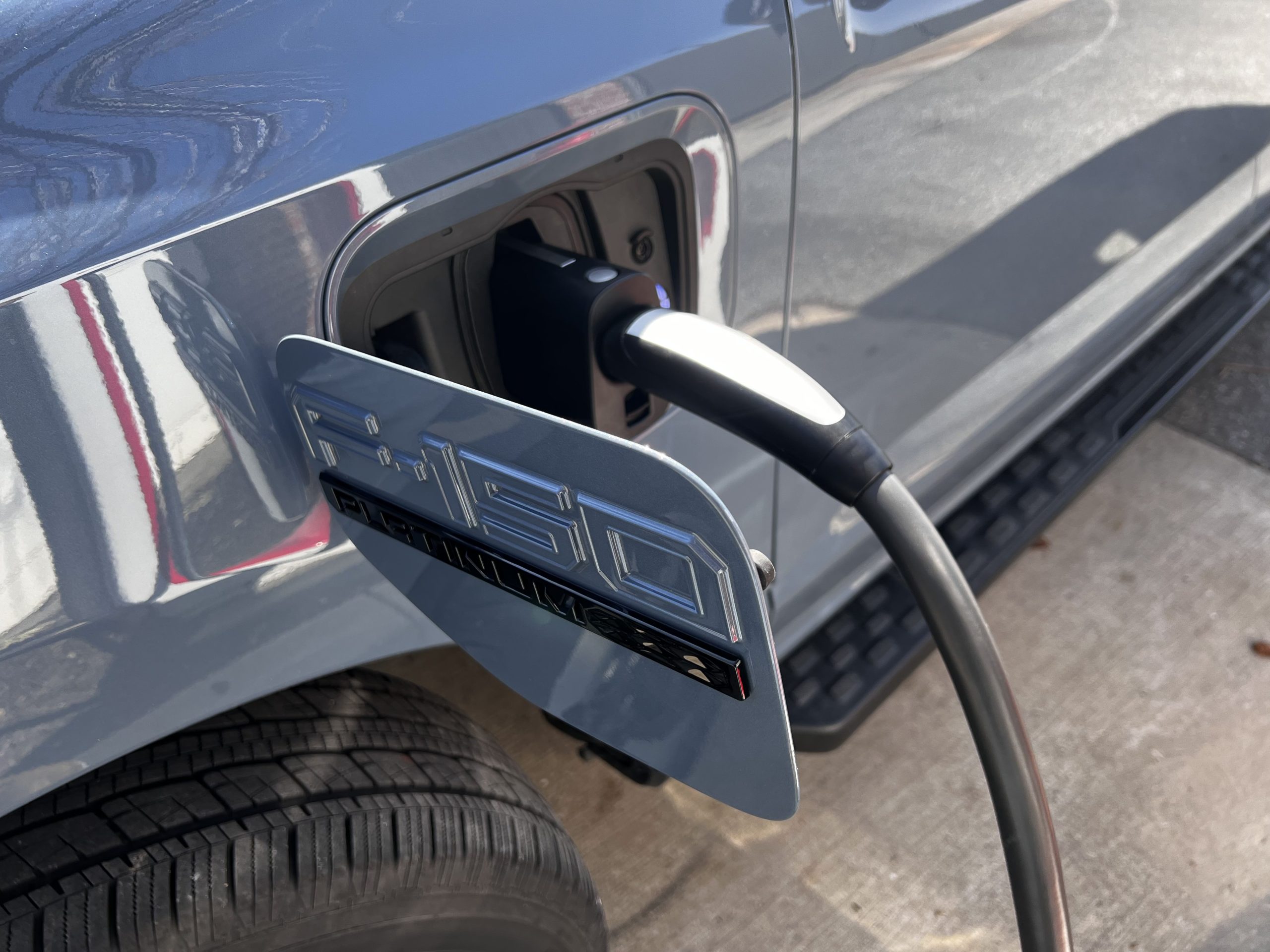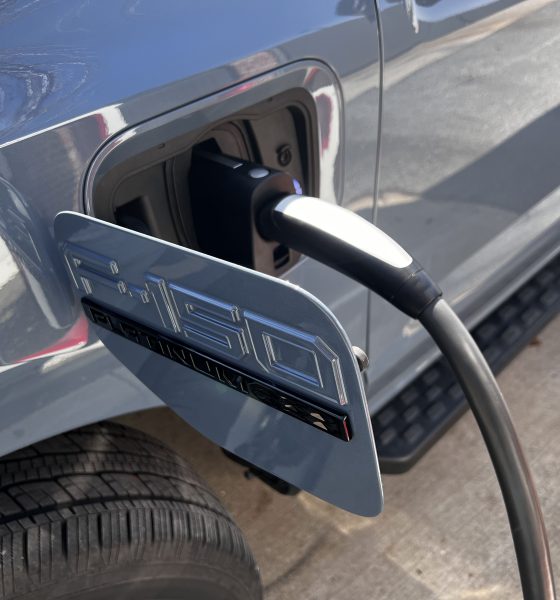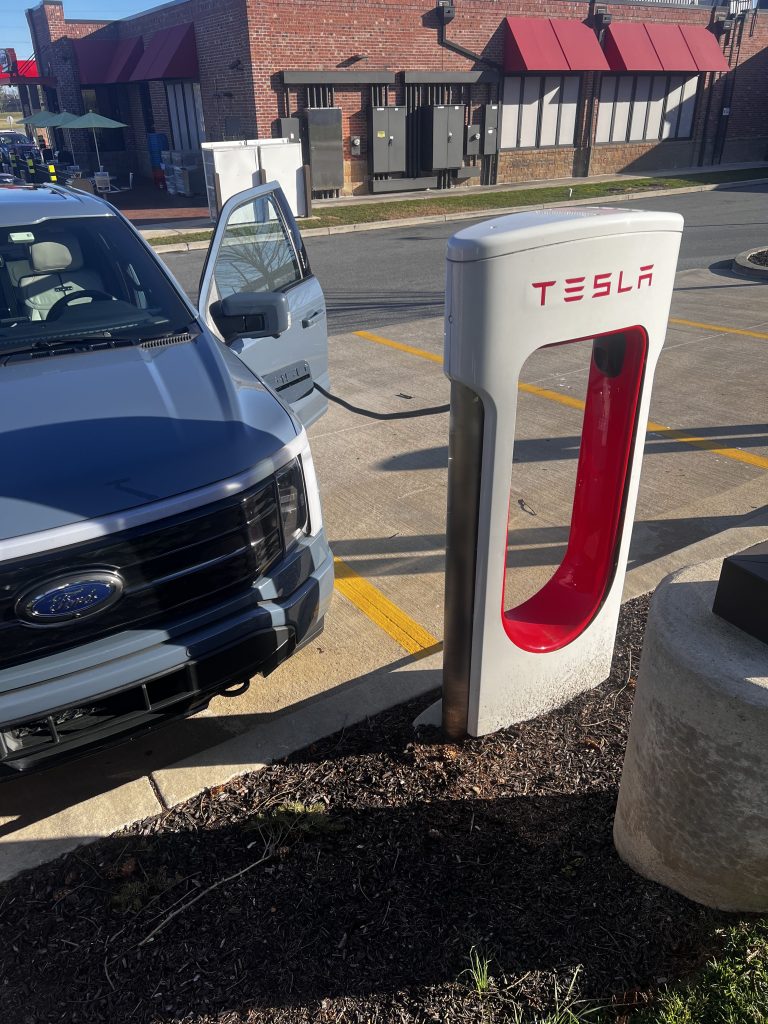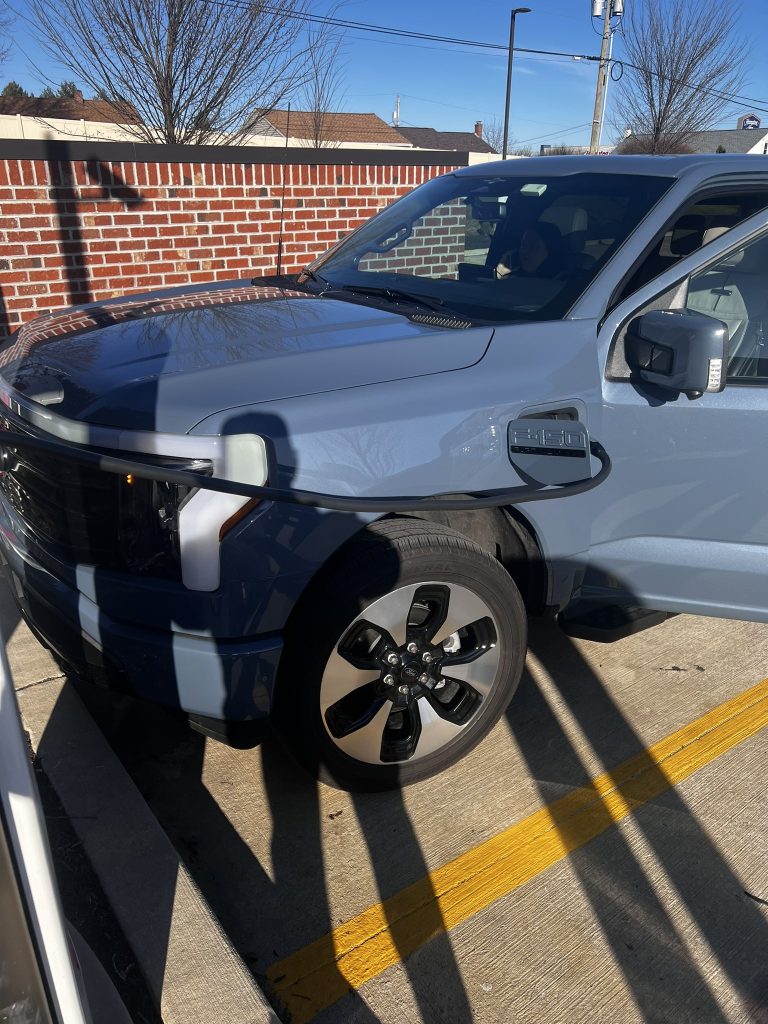

News
I took a Ford F-150 Lightning to Tesla Superchargers: The Good and Bad
Update 4:33 pm: Charge rates updated for accuracy. FordPass statistics were incorrect. Added paragraph 7 to add detail regarding use of Ford App to charge.
Ford and Tesla unified the electric vehicle community by announcing a strategic decision to collaborate.
Last month, Ford gained access to Tesla’s Supercharger Network, giving non-Tesla EV drivers their first opportunity to charge at its piles across North America.
Ford was pleasant enough to send an F-150 Lightning to my house, drop it off, and allow me to drive it for three days. They also sent a Charging Adapter, which was necessary for using Tesla Superchargers.
The truck arrived at my house early Monday morning, and I was sure to take it for a spin to deplete some of the range before I drove it to my nearest V3 Supercharger. This was my first bit of criticism, as the closest Supercharger that would enable the F-150 Lightning to charge was around 45 minutes away. It is not the closest Tesla Supercharger to me, as there is one just ten minutes away, but its V2 capabilities would not allow me to charge a non-Tesla EV.
Ford announces Tesla Supercharger access to F-150 Lightning, Mustang Mach-E drivers
The truck was great, but that’s another story altogether.
First Impressions
I arrived at the first Supercharger on Monday evening, ready to give this a first go. I pulled into a spot in a row of unoccupied superchargers; the Lightning’s charging port is located just behind the left front tire, so you need to take up two spots, something that Tesla is working on.
I logged into the Ford app and selected the charger in front of me. This ” unlocked” the Supercharger, enabling me to grab the cable and attach the adapter. Charging was ready, and it was as simple as plugging in and sitting back in the driver’s seat, where the heads-up display told me my current percentage, and an estimated time to 90 percent state of charge.
It was super tight to get the cable to reach. I had some room to pull forward, admittedly, but I was driving a truck that I didn’t own, and I didn’t want to take the chance of scraping the underbody of the vehicle. Even with repositioning myself and trying to angle the truck in order to reach the cable comfortably, it was hard to get the cable to get to the connector.
A few extra feet would help even the most cautious drivers charge more easily, which I believe is important.
Overall, it was a good experience. My charging statistics for this session were:
- Charging Power – 106 kW
- Energy Added – 37.4 kWh
- Time Charged – 21 minutes
- Distance Gained – 96 miles
- Cost – $21.16
It was not an overwhelmingly time-consuming process. It was quick, it was easy, and it was nice to have access to a Supercharger. When I have Ford EVs, I usually have to charge at my local grocery store on a low-speed Volta charger, which will give me around 10-12 miles per hour.
Second Charging Session
My second session was much better. I was able to get into a Supercharger stall that was put on the side of the spot as it was an end space, so it was easier and much more reasonable to pull into.
There was significantly less tension on the Supercharger cable, which I think will increase longevity and keep the number of operable stalls up.
This session was smoother in terms of pulling in and charging. While longer cables will eliminate a lot of the problems I had during the first charging session, Tesla’s end-spot Superchargers are super ideal for non-Tesla EVs. This was my preferred space, and I would have used it the day prior if another vehicle wasn’t already utilizing it.
My charging stats for this session were:
- Charge Power – 106 kW
- Energy Added – 48.3 kWh
- Time Charged – 33 minutes
- Distance Gained – 115 miles
- Cost $22.08
Quality of the Adapter
The adapter Ford sent along was super quality, solid, and heavy. It felt like a piece of necessary equipment that is designed to last several years and won’t break on you due to inferior quality.
It was packaged nicely and included a nice message from CEO Jim Farley. It simply attaches to the Tesla Supercharger Cable and goes into the Ford EV, locking in place:
Forgot how much I love driving the Lightning, honestly my favorite EV to cruise around in!!
Ford overnighted me the adapter for Superchargers as well! pic.twitter.com/0VGE0AKxj6
— Joey Klender (@KlenderJoey) March 11, 2024
I was impressed by the quality of the adapter and I believe it would last years for Ford EV owners who plan to use it to access Superchargers.
Final Thoughts
Ford EV drivers are going to use Tesla Superchargers for years to come, and I think that what I experienced was a good start of the overall charging experience.
Everything was high-quality, fast, effective, and easy to use. It felt nice to roll into a Tesla Supercharger and gain adequate of range in a short period of time, and it was something that I feel a lot of EV drivers will appreciate, even if it is a tad pricey at this point in time.
I think that the lengthening of Supercharger cables will pay dividends, but I also think that Tesla could build new Supercharger stations with mandatory end spot positioning. This enables easier access to the Superchargers for non-Tesla EVs.
I’d love to hear from you! If you have any comments, concerns, or questions, please email me at joey@teslarati.com. You can also reach me on Twitter @KlenderJoey, or if you have news tips, you can email us at tips@teslarati.com.

Elon Musk
Elon Musk’s xAI closes upsized $20B Series E funding round
xAI announced the investment round in a post on its official website.

xAI has closed an upsized $20 billion Series E funding round, exceeding the initial $15 billion target to fuel rapid infrastructure scaling and AI product development.
xAI announced the investment round in a post on its official website.
A $20 billion Series E round
As noted by the artificial intelligence startup in its post, the Series E funding round attracted a diverse group of investors, including Valor Equity Partners, Stepstone Group, Fidelity Management & Research Company, Qatar Investment Authority, MGX, and Baron Capital Group, among others.
Strategic partners NVIDIA and Cisco Investments also continued support for building the world’s largest GPU clusters.
As xAI stated, “This financing will accelerate our world-leading infrastructure buildout, enable the rapid development and deployment of transformative AI products reaching billions of users, and fuel groundbreaking research advancing xAI’s core mission: Understanding the Universe.”
xAI’s core mission
Th Series E funding builds on xAI’s previous rounds, powering Grok advancements and massive compute expansions like the Memphis supercluster. The upsized demand reflects growing recognition of xAI’s potential in frontier AI.
xAI also highlighted several of its breakthroughs in 2025, from the buildout of Colossus I and II, which ended with over 1 million H100 GPU equivalents, and the rollout of the Grok 4 Series, Grok Voice, and Grok Imagine, among others. The company also confirmed that work is already underway to train the flagship large language model’s next iteration, Grok 5.
“Looking ahead, Grok 5 is currently in training, and we are focused on launching innovative new consumer and enterprise products that harness the power of Grok, Colossus, and 𝕏 to transform how we live, work, and play,” xAI wrote.
Investor's Corner
Tesla gets price target bump, citing growing lead in self-driving

Tesla (NASDAQ: TSLA) stock received a price target update from Pierre Ferragu of Wall Street firm New Street Research, citing the company’s growing lead in self-driving and autonomy.
On Tuesday, Ferragu bumped his price target from $520 to $600, stating that the consensus from the Consumer Electronics Show in Las Vegas was that Tesla’s lead in autonomy has been sustained, is growing, and sits at a multiple-year lead over its competitors.
CES 2026 validates Tesla’s FSD strategy, but there’s a big lag for rivals: analyst
“The signal from Vegas is loud and clear,” the analyst writes. “The industry isn’t catching up to Tesla; it is actively validating Tesla’s strategy…just with a 12-year lag.”
The note shows that the company’s prowess in vehicle autonomy is being solidified by lagging competitors that claim to have the best method. The only problem is that Tesla’s Vision-based approach, which it adopted back in 2022 with the Model 3 and Model Y initially, has been proven to be more effective than competitors’ approach, which utilizes other technology, such as LiDAR and sensors.
Currently, Tesla shares are sitting at around $433, as the company’s stock price closed at $432.96 on Tuesday afternoon.
Ferragu’s consensus on Tesla shares echoes that of other Wall Street analysts who are bullish on the company’s stock and position within the AI, autonomy, and robotics sector.
Dan Ives of Wedbush wrote in a note in mid-December that he anticipates Tesla having a massive 2026, and could reach a $3 trillion valuation this year, especially with the “AI chapter” taking hold of the narrative at the company.
Ives also said that the big step in the right direction for Tesla will be initiating production of the Cybercab, as well as expanding on the Robotaxi program through the next 12 months:
“…as full-scale volume production begins with the autonomous and robotics roadmap…The company has started to test the all-important Cybercab in Austin over the past few weeks, which is an incremental step towards launching in 2026 with important volume production of Cybercabs starting in April/May, which remains the golden goose in unlocking TSLA’s AI valuation.”
Tesla analyst breaks down delivery report: ‘A step in the right direction’
Tesla has transitioned from an automaker to a full-fledged AI company, and its Robotaxi and Cybercab programs, fueled by the Full Self-Driving suite, are leading the charge moving forward. In 2026, there are major goals the company has outlined. The first is removing Safety Drivers from vehicles in Austin, Texas, one of the areas where it operates a ride-hailing service within the U.S.
Ultimately, Tesla will aim to launch a Level 5 autonomy suite to the public in the coming years.
Elon Musk
Elon Musk’s Biggest Revelations on AI, Robots, and the Future of Work from the Moonshots Podcast

Elon Musk’s appearance on the Moonshots with Peter Diamandis podcast was packed with bold predictions, candid admissions, and surprising tech insights. The nearly three-hour conversation covered everything from artificial intelligence to humanoid robots, geopolitics, and the future of work. Here are the top 10 most intriguing takeaways:
-
Aggressive AGI Timeline Predictions
Musk offered a detailed view on when artificial general intelligence (AGI) could emerge, suggesting it may arrive sooner than many expect, emphasizing both transformative potential and risks.
-
U.S. vs. China in the AI Race
He discussed the strategic competition between the United States and China over AI development, noting that geopolitical dynamics will shape how and who leads in the next decades.
-
Future of Job Markets
Musk touched on how AI and automation could reshape employment, predicting massive boosts in productivity alongside potential disruptions in traditional work structures.
-
Clean Energy Transition
A recurring theme was the role of clean energy in future economies, with Musk reiterating the importance of scaling sustainable power generation and storage.
-
Humanoid Robots Are Coming
On the podcast, Musk elaborated on Tesla’s work on humanoid robots, hinting at timelines and applications that go beyond factories to general-purpose assistance.
-
Tesla Roadster “Last Human-Driven Car”
Outside the core discussion topics, Musk teased features of the upcoming Tesla Roadster — calling it “the best of the last of the human-driven cars” and suggesting safety won’t be its main selling point.
-
The Role of AI in Clean Energy and Robotics
Linking AI to both energy optimization and robotics, Musk explained how smarter systems could accelerate decarbonization and task automation across industries.
-
U.S. Innovation Leadership
Musk argued that maintaining American leadership in key tech sectors like AI, space, and robotics should be a national priority, with thoughtful policy and investment.
-
Job Creation vs. Job Elimination
While acknowledging automation’s disruptive effects, he also outlined scenarios where new industries and opportunities could emerge, particularly in AI, space, and advanced manufacturing.
-
Long-Term Vision for Humanity
Throughout the conversation, Musk revisited his long-term philosophical views — including a belief in humanity’s responsibility to become a multi-planetary and technologically empowered species.
Whether you agree with Musk’s optimism or not, the podcast offers a window into the thinking of one of the most influential figures in tech today, in and why his visions continue to spark debate and inspiration.













